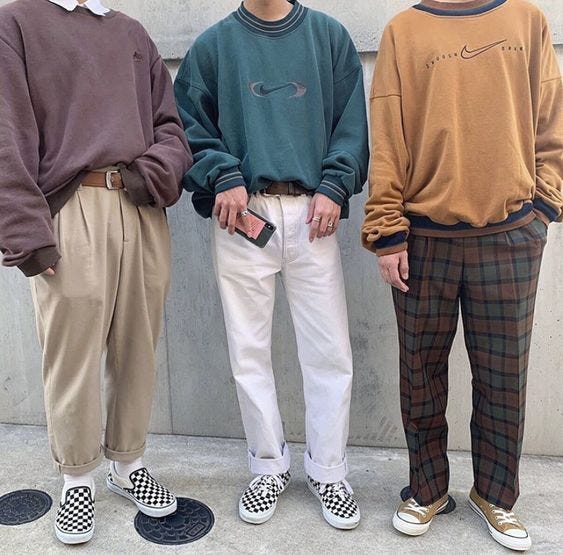The Soft Boy Brigade
Was He “Written By a Woman” or Is He Just Wearing Nail Polish?
TW: mentions sexual assault and rape
On October 10th 2022, indie music star Rex Orange County’s name began trending on Twitter. It wasn’t trending because of the release of his signature light-hearted, groovy music about love and heartbreak, but rather because he was charged with six counts of sexual assault.
Upon searching the singer’s name on Twitter, I wasn’t surprised to see people upset by the breaking news but was slightly shocked to witness the kind of mourning that Internet users were undergoing. People couldn’t seem to believe that this floppy-haired, striped-sweater-clad British singer, with his romance songs and primary-colored, Sesame Street-esque branding could be capable of committing such moral ills. “NOT REX ORANGE COUNTY” read one tweet and “REX ORANGE COUNTY DID WHAT??!!” read another. Everywhere online people were grieving the rainbow-sunshine-golden retriever stamped guy they assumed was one of the “good ones.”
Whether we like it or not, aesthetics are a key feature of identity. And with how identity has become inextricably tied up with politics, aesthetics too have become a significant attribute of politics. Whether it’s zoot suits worn in American immigrant communities of the 1940s, prolific drag and ball culture born within LGBTQ+ communities of the 1970s, or baggy jeans common in skater and hip-hop culture of the 1990s, aesthetics have been a fundamental marker of counter-cultural movements and revolutions for years.
Physical characteristics contribute to the stereotypes we form about others around us. Growing up, we blatantly and subliminally learn from mainstream media, school, our families, and more that how people dress, walk, and even style their hair communicates whether they’re safe to be around or whether we should cross the street when we pass them.
When Ted Bundy raped and murdered about thirty women in the 1970s, many news outlets were quick to point to his charm, charisma, and good looks as playing key roles in his getting away with that many attacks. People simply couldn’t believe that someone so educated and handsome - someone who didn’t have the typical serial killer “look” - could commit such violent acts. This irony is, of course, what’s played off in films like American Psycho (2000). Part of what makes the film so appealing - apart from its commentary on gender roles, misogyny, and corruption bred from modern-day capitalism - is that protagonist Patrick Batemen is a handsome and rich serial killer. The juxtaposition of gleaming white-collar charm and violent apathy is a contrast our conditioned brains haven’t historically been equipped to compute based on the stereotypes promoted in mainstream American culture.
You can’t see what kinds of organisms are lurking on an ocean floor by merely glancing at waves lapping on the beach. Appearances are deceiving.

A type of appearance that has become increasingly popular among cisgender, heterosexual boys and men - particularly online - is what many have dubbed the “soft boy” look.
Soft boy’s curly hair is lazily - but always perfectly - touseled around his eyes. He can be seen wearing straight-leg trousers or slouchy corduroy pants with an oversized hoodie, cardigan, or thrifted “grandpa” sweater. He journals. He carries around a camera. He might be donning an earring or two, some lightweight jewelry, and his nails are painted. Perhaps a bit sloppily but (endearingly!) painted nonetheless.
The soft boy appears - wouldn’t you know - softer around the edges. His deviation from markers of traditional western masculinity makes him appear non-threatening to girls and women and thus an appealing romantic prospect. He would never gaslight or violate you. I mean, his nails are painted! He’s just that kind of guy!
When I think of figureheads that embody the soft boy aesthetic, K-pop idols, Harry Styles, and Timothée Chalamet are some of the first to come to mind. But rest assured, Rex Orange County is on the list.
I should clarify that there’s nothing wrong with people choosing to dress and present themselves the way they feel most comfortable. And I think it’s exciting that in mainstream fashion trends, the once bolder lines dividing masculine and feminine appearances are starting to blur. Having rigid gender roles hinders men, women, and non-binary people alike, albeit in different capacities depending on one’s identity and setting. Anyone should be able to express themselves how they choose to and people of all genders should be invited to lean into softness.
Being a former One Direction and current Harry Styles fan, it’s not hard to deduce that I am somewhat of a fan of the soft boy aesthetic. Sensitivity and emotional awareness are beneficial traits for people to have themselves and seek in partners.
That being said: a guy with painted nails is not exempt from exhibiting misogyny.
Similar to the countless assumptions folks have made for years about business-formal, clean-shaven masculinity and its supposed refinement, or flannel-lumberjack-scruffy-cowboy masculinity and its alleged wholesomeness, and every other strain of masculinity around and between those two, presumptions are constantly made about soft boys online.
Due to their rejection of conventional masculinity - which has long been implicitly and explicitly associated with the subjugation of femininity - soft boys have a dreamy, feminist air about them. As if they just waltzed out of a young adult romance novel, a Bon Iver album playing through their corded earbuds and vintage rings gracing their gentle knuckles.
An aura so powerful that they’re dubbed forward-thinking or “written by a woman” automatically. Often without even having to do anything. An empty ally in a Goodwill cable-knit sweater.
This type of conversation has long been a critique of Harry Styles, specifically in the context of LGBTQ+ allyship and “queer baiting.” Many supporters of Harry have long hailed him - a straight, cisgender white man - for defying gender norms and being a fierce ally. And while he’s done a great deal of waving pride flags around his stage and donning the covers of magazines in dresses, he’s only gestured vaguely towards his support for “equality.” Dancing around in dresses, twirling flags, and wearing sequins and nail polish isn’t bad (I’d argue it’s even good! In a sense!) but it doesn’t make Harry an immediate top champion for the LGBTQ+ community. Especially not when openly gay and trans activists and artists have been decidedly putting their careers and lives on the lines for years to create tangible waves of civil and cultural progress. All of which may have involved veering their appearance away from the norm - but also much more.
And so we return to our thesis: aesthetics are political. Not just in the sense that they can help bolster support for political issues or help unify marginalized groups dubbed “political,” but they’re also political in the sense that they can manipulate. They can be intentionally and inadvertently strategic.
It may not be the case that Rex Orange County’s soft boy casing was an intentionally calculated aesthetic choice to appeal to young women listeners and mask sexist behaviors. But if one thing’s for certain, it’s that appearances don’t guarantee a certain kind of demeanor on any end of the spectrum. Sometimes straight boys have more feminist outlooks. And other times, their facade is as artificial as the sparkly varnish coating their nails.







Do Revenge (2022) does this quite well with Max Broussard. He's got earrings, painted nails, not afraid to sport florals but underneath the surface he is a chauvinistic prick.